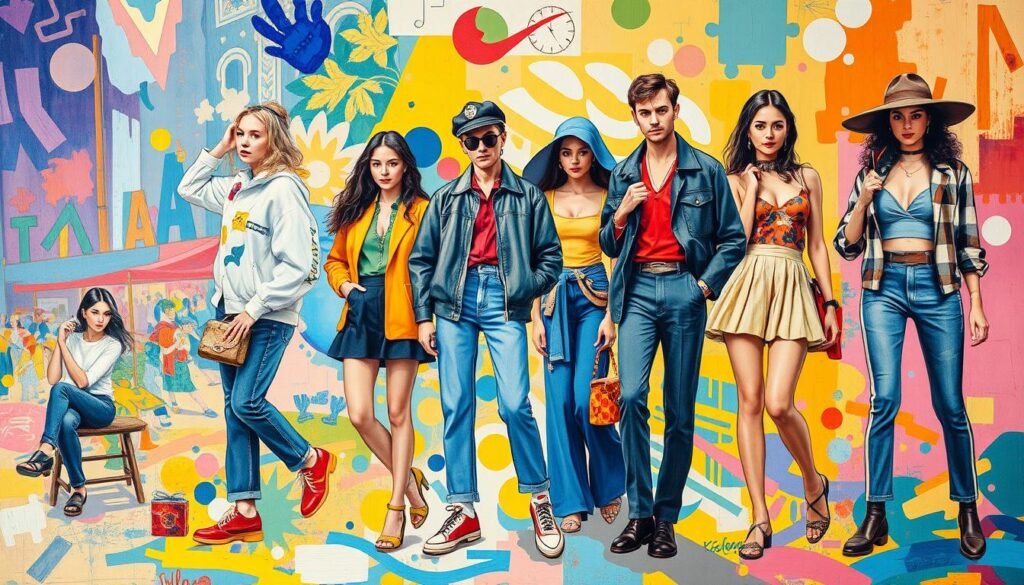Have you thought about how sustainability and technology are changing the future of clothing? The fashion industry is at an important turning point. It is blending tech advances with eco-friendly fashion practices. Studies show that people now care about more than looks. They want clothes that are functional, green, and tailored to them. Big brands are keeping up with these changes to meet new consumer needs and tackle environmental issues. This mix of innovation, responsibility, and inclusivity is guiding the fashion world’s future direction.
Key Takeaways
- 63% of Gen Z consumers are interested in digital garments, highlighting the rise of virtual fashion.
- Annual social commerce sales in the US could reach $56 billion in the next two years, signifying a shift towards online shopping.
- 80% of consumers expect fashion brands to accommodate their shopping preferences, emphasizing the need for personalization.
- 71% of consumers are willing to engage more with brands that integrate augmented reality (AR) into their shopping experience.
- 74% of fashion organizations are adopting cloud technology to streamline operations and meet market demands.
- 90% of fashion and apparel companies anticipate revenue growth in 2023, showing a resilient industry outlook.
The Evolution of the Fashion Industry Landscape
The fashion industry has changed a lot due to new tech and changes in what people want. This shows how fashion has moved from being handmade to today’s fast fashion. Brands need to keep up with fashion industry trends to stay ahead in a global, digital market.
Today, as people’s likes change, fashion brands must watch trends and adjust quickly. The rise of shopping both online and in stores has changed how we shop. This makes it important for stores to manage their stock well to meet what people want.
Also, using data to understand what people like in fashion is key. Analyzing how people interact with brands online helps see trends. Yet, dealing with a lot of data can be hard for many stores. Using the cloud has become a must for fashion companies to quickly react to new trends and work more efficiently.
People are now more concerned about how their clothes impact the planet. This has made brands focus more on being open and inclusive in what they sell, showing different body types, cultures, and genders. The growing popularity of buying previously owned clothes shows a move towards sustainability without spending a lot. Fashion brands should use these insights to connect better with their audience.

Technology’s Role in Modern Apparel Design
Technology has drastically changed how we make clothes. Designers use new tools to create and improve their work. Computer-Aided Design (CAD) and Computer-Aided Manufacturing (CAM) are crucial. They help make patterns and construct garments with great care. This way, companies can create top-notch items and cut down on waste.
Computer-Aided Design (CAD) and Manufacturing (CAM)
CAD and CAM boost fashion designing. They allow for detailed designs with high accuracy. These apparel design technologies make the designing process smoother. They keep brands ahead in the market. Designers can quickly try new styles and fine-tune them thanks to swift prototyping. This boosts creativity and how quickly they can respond to trends.
Artificial Intelligence in Fashion
Artificial Intelligence (AI) is taking over fashion fast. Big names like Zara and H&M are using AI to do better and offer custom services. AI studies customer data and trends, improving stock control and predicting needs more accurately. AI in fashion not only meets customer needs but also cuts down on extra stock and waste.

Material Innovations Driving Sustainable Practices
The fashion world is changing for the better. It’s embracing sustainable practices more than ever before. Brands are now picking materials that are kind to the planet but still maintain quality. Adidas and Stella McCartney lead by example, showing it’s possible to be stylish and responsible.
Bio-Based and Alternative Textiles
Bio-based textiles are a game-changer for fashion. They use things like agricultural waste and mycelium, reducing the carbon impact. Brands are getting creative with materials, like BioFluff’s entirely plant-based fur alternative. It’s innovating with renewable plant fibers, making sustainability a core part of fashion.
The Impact of Smart Fabrics
Smart fabrics are reshaping fashion with technology. They blend in sensors and tech to make clothes more than just outfits. Now, they can check your health, control your temperature, and interact with you. This makes clothes more functional, meeting the wearer’s needs in new ways.
| Innovation | Example Brand | Material Type | Environmental Benefit |
|---|---|---|---|
| Mycelium Textiles | Ecovative | Plant-based leather | Reduces reliance on animal products |
| BioFluff | BioFluff | Plant-based fur alternative | Minimizes environmental impact from fur production |
| Smart Fabrics | Wearable technology brands | Tech-integrated textiles | Provides health and performance data |
The drive for sustainable materials in fashion keeps growing. Companies aim to find eco-friendly textile partnerships. This is pushing for better sustainability across the board in fashion.
3D Printing: Transforming Production Processes
3D printing is changing how we make clothes. It lets designers create complex shapes that were hard to make before. They can now quickly try new designs, keeping up with fashion’s fast changes.
This technology meets the demand for unique items made just for you. It cuts down on extra stock and waste, making fashion more sustainable. It uses only the materials needed, helping our planet.
Soon, we’ll see clothes that can check your health or change color. Fashion and tech joining forces will lead this cool new trend. It mixes art with science in fresh ways.
3D printing is becoming easier to find and cheaper, affecting both high-end fashion and everyday clothes. Designers like Iris van Herpen and Travis Fitch are already using it to make unique outfits. The future looks bright for 3D printed fashion, with a big market growth expected.
| Features | Traditional Manufacturing | 3D Printing |
|---|---|---|
| Material Waste | High due to excess production | Low, only necessary material used |
| Customization | Limited options | High, unique designs possible |
| Production Speed | Slow, longer lead times | Fast, rapid prototyping capabilities |
| Flexibility | Rigid manufacturing processes | Flexible, allowing for complex designs |
The Role of Robotics and Automation
The robotics in fashion sector is changing the game. It makes making clothes faster and the quality better. Brands are using more machines in making clothes. This helps a lot in tasks like cutting, sewing, and handling fabric. Thanks to new tech, companies can keep up with trends quickly and keep quality high.
Enhancing Efficiency and Precision in Manufacturing
Using robots and machines boosts manufacturing efficiency. It also lets brands make clothes closer to where they sell them. This means less need for making clothes far away. For example, Zara uses AI to quickly adapt to new fashion trends. This cuts down the time it takes to produce.
Plus, AI can look at social media to guess changes in what people want to wear. This is key for picking the right amount of clothes to make and sell. Automation in apparel is very important for making accurate guesses.
Putting money into machines, like robots that help with sewing and 3D designs, changes how clothes are made. This might mean fewer jobs in some areas. But, there are good things too, like better working conditions and safety. Using these new tools helps fashion brands stay ahead as the market changes fast.
Fashion Industry Insights: Trends in Personalization
The fashion world is changing fast, focusing on what customers want. Now, 71% of shoppers expect brands to know their tastes and offer personalized products. This means there’s a growing demand for clothes that not only fit well but reflect individual styles and shapes.
The Demand for Custom-Fit Garments
Fashion brands are turning to tech like AI and body scanning to meet this need. They use these tools to make clothes that fit perfectly. AI helps by giving super personal style tips based on lots of data. This makes shopping better for people and is also good for the planet because clothes last longer.
Technological Innovations that Enhance Customer Experience
Companies are investing in new tech to connect with customers better. Virtual dressing rooms and smart chatbots make shopping smooth and fun. Using this technology, brands can figure out what people really like. This means they can keep updating their products to stay ahead.
| Aspect | Current Trends | Future Implications |
|---|---|---|
| Consumer Expectations | 71% expect personalized interactions | Increased loyalty and retention |
| AI in Fashion | $16.3 billion forecasted market value by 2030 | Enhanced marketing strategies through data-driven decisions |
| Environmental Impact | 23% rise in carbon emissions expected | Significant reductions possible through personalized, made-to-order fashion |
| Challenges | High production costs and scalability issues | Investment in advanced manufacturing needed |
| Data Privacy | Concerns over consumer data protection | Strengthening data security protocols critical |
Brands like Tianruiyi are leading the way with a focus on customers and quality. They’re blending these new trends with a commitment to being green. Their strategy shows how the future of fashion could look with personalized service and cutting-edge tech.
Learn more about their values and their innovative plans.
The Rise of Digital Clothing and Virtual Fashion
Digital clothing and virtual fashion are changing the apparel industry. People are looking for new ways to show their style online. The digital clothing market was worth $498.7 million in 2021. By 2031, it’s expected to hit $4.8 billion. This growth shows people’s increasing interest in fashion for the metaverse. A demographic called Digi-Sapiens, making up 45% of the world’s population, is driving this trend. They hold 55% of the spending power globally.
Integration with the Metaverse
Platforms like The Fabricant and DressX are leading in virtual fashion. They let users buy and wear digital clothes. Brands are getting into this trend with unique collections. For example, Gucci made $5.7 million from a nine-piece fashion NFT collection. Balenciaga teamed up with Fortnite, letting players dress their avatars in designer digital outfits. This shows how gaming and fashion are blending together.
The metaverse fashion market could reach $800 billion by 2024. This new space allows for innovative experiences and supports sustainable choices with digital-only collections. Companies like Carlings launched a digital collection named “Neo-Ex.” With this growth, businesses are exploring better ways to engage users online. They’re focusing on social media and AR technology for virtual try-ons. This highlights how digital fashion can promote responsible consumption.
Sustainability in Fashion: Current Practices and Future Directions
Since the late 1980s, sustainability in fashion has aimed to cut down on harming the environment and urged smart shopping. The idea of circular fashion is central, questioning the usual ‘buy-use-dump’ practice. It pushes for durable, recyclable, and ethically made clothing, gaining fans who care deeply about the planet.
Circular Fashion and Resale Markets
The rise of resale markets shows young shoppers love green business ideas. These trends show a move from throwaway fashion to choices that last longer. Fashion brands are getting on board, starting return programs and teaming up with resale sites to promote a greener circle. Such efforts help clothes live longer, cutting down on trash.
Brands Leading the Sustainability Movement
Brands like Pangaia and Stella McCartney are at the forefront with green innovations. They use planet-friendly materials and support circular fashion to lessen their eco-footprint. By following these leaders, other labels are inspired to go green, pushing for a united effort towards kinder fashion. The goal is a fashion world that honors the earth and its people, making a path for the future.
The Importance of Social Media in Fashion Marketing
Social media has become key for fashion brands to connect with their audience, especially Gen Z. On platforms like Instagram and TikTok, fashion brands share their stories and visuals. This helps them reach lots of people who love fashion.
Engaging Gen Z through Digital Platforms
Fashion influencers play a big role in setting trends and making brands popular. They know how to grab people’s attention, making them loyal to the brand. Brands need to make their content personal. This makes shoppers feel special and improves their buying experience.
Brands use smart analytics to better their marketing. This makes sure their ads hit the right note. Combining social media with online shopping increases sales on these platforms.
With artificial intelligence, shopping gets even more personal. It suggests products you might like based on what you’ve looked at before. Brands can see what’s trending and adjust their plans quickly.
- Instagram has a huge audience of over 1 billion monthly users for fashion marketers.
- TikTok’s quick growth, with 2 billion downloads, shows it’s great for sharing quick fashion videos.
- Over 400 million people use Pinterest to find fashion ideas and see what’s going to be popular.
These platforms help fast fashion brands get their newest styles out quickly. But, they also make people think about how fashion affects the environment. Today, consumers want brands to do better. Social media has changed the way fashion brands market themselves. It also changed what shoppers expect from them.
Challenges Faced by the Apparel Industry
The fashion industry faces big challenges. Resource depletion and waste management are key issues. They affect how brands work. Brands must be profitable while caring for the environment. This is because consumers and regulators are watching closely.
Resource Depletion and Waste Management Issues
Statistics show the fashion industry needs urgent changes. It causes about 8-10% of the world’s carbon emissions. This harms the environment. Every year, it also creates 92 million tons of textile waste. This is a huge waste management problem.
The industry uses natural resources poorly. For example, less than 1% of cotton was recycled in 2020. Consumers want change. 67% say sustainable materials are important when they shop. This changes what companies do. They are now looking for eco-friendly options.
Supply chain problems are another big challenge. Over half of fashion executives admit it’s an issue. Sustainability is now a top priority for them. About 15% say it’s a major concern. Brands are moving towards sustainable practices. They want to use resources better and manage waste more effectively.
| Issue | Statistical Insight |
|---|---|
| Global Carbon Emissions | 8-10% of total emissions |
| Annual Textile Waste | 92 million tons |
| Cotton Recycling Rate | Less than 1% |
| Consumer Demand for Sustainability | 67% prioritize sustainable materials |
| Executives Concerned about Sustainability | 15% ranking it as a top-three concern |
The Future of Fashion Retail: Omnichannel Strategies
The future of fashion retail is being reshaped by omnichannel retail. As consumers change, brands need to adapt to give smooth experiences everywhere. This is key to attract Gen Z, who are about 40% of global buyers with $150 billion to spend. Nowadays, buyers want interactive and personalized shopping, making experiential retail a must.
Visual storytelling is becoming more important. Around 93% of shoppers focus on visuals when buying. Brands are now creating engaging visuals to improve online shopping. About 80% of what we learn is through visuals. The growth of social media shopping highlights this trend, with sales possibly hitting $56 billion in the US by 2027.
Recent stats underline the value of omnichannel strategies:
| Statistic | Value |
|---|---|
| Marketers wanting to grow consumer trust through omnichannel | 84% |
| Marketers reporting budget shifts from offline to online purchases by 2025 | 76% |
| Higher order rate for campaigns using more than three channels | 494% |
| Brands testing analytics for channel optimization | 88% |
| Brands actively engaging in e-commerce personalization | 97% |
Sustainability is now a big trend, with modern shoppers leaning towards ethical brands. This fits with omnichannel strategies, as businesses must ensure their services online and off mirror these values. As brands hone their approaches, mixing digital ads with tech like virtual try-ons and augmented reality opens new doors. The future of fashion retail is about mastering multi-channel shopping while building loyalty and trust.
Consumer Behavior Shifts Post-Pandemic
The pandemic changed how we shop, sparking a new kind of consumer behavior. People now focus more on buying from ethical companies. Brands that share these values see more customer interest and loyalty.
Ethical Consumption Trends
About 66 percent of shoppers will spend more on sustainable brands now. They want products that are good for the planet, showing a big change in fashion. Since the pandemic began, 64 percent are buying more sustainable items.
- 51 percent of consumers plan to spend more on fun experiences and clothes after the pandemic.
- Millennials with higher incomes will likely spend more on fashion, travel, and food.
- Online shopping grew by 20 percent since January 2020. Ninety-two percent who tried it in 2019 kept shopping online.
- Seventy-five percent of people tried new ways to shop, looking for the easiest and best deals.
People wanted comfy clothes during the pandemic, so searches for loungewear and activewear went up by 59 percent and 41 percent. This shows a big change in what we wear, with ethical brands getting more popular.
Also, 39 percent of younger shoppers, especially Gen Z and millennials, switched to new, more ethical brands. This is part of a larger move towards thoughtful shopping. Brands now need to be creative and adjust to these new preferences.
Conclusion
The fashion world is on the edge of a big change. It’s getting more high-tech, focusing on being green, and listening to what buyers want. Before COVID-19, it made about $1.7 trillion. Its quick bounce back in sales, especially in clothes and shoes, shows its strength. Brands that take care of the environment and welcome everyone will do well in this evolving market.
Going green is now a big deal in fashion. Brands like Eileen Fisher and Patagonia lead the charge with circular fashion. This means they use materials that are better for the planet, like recycled polyester and organic cotton. Stella McCartney is also doing this, changing how clothes are made. This approach reduces waste, makes clothes last longer, and meets customers’ wishes for more ethical products.
Tech is changing fashion in big ways. For example, Gucci lets you try on clothes virtually with augmented reality. And artificial intelligence is making design and distribution better. Keeping up with these tech advances is key for those who want to be leaders in fashion. The focus on style, being green, and new tech shows in insights from top companies like LVMH and Nike. They prove fashion is about more than just looking good.
FAQ
What are the main factors shaping the future of the fashion industry?
The fashion industry’s future is shaped by tech advances, sustainability, and changes in how people shop. Brands need to keep up with these trends to stay on top. And they must act responsibly too.
How is technology influencing apparel design?
Technology is key in modern apparel design. It brings in tools like CAD and AI. These innovations speed up designing, boost creativity, and make shopping personal.
What are some examples of sustainable practices in fashion?
Top brands are using eco-friendly materials and pushing for circular fashion. Examples include Adidas and Stella McCartney. They are also clear about their supply chains and offer programs to take back used items.
How is 3D printing changing the fashion production process?
3D printing lets brands make custom clothes as needed. This reduces waste and supports sustainability. It also lets designers try out complex designs which are tough with old methods.
What role do social media platforms play in fashion marketing?
Social media helps reach consumers, especially those in Gen Z. It uses influencers and targeted ads. Instagram and TikTok help build community, boost brand loyalty, and awareness.
What is the significance of sustainable materials in fashion?
Using sustainable materials is key to lowering the fashion industry’s environmental harm. Brands are trying out bio-based textiles and new fabrics. These materials are both chic and green.
How is consumer behavior shifting in the post-pandemic era?
After the pandemic, people are focusing on buying from ethical brands. They want products from companies that share their values. They look for sustainability, open practices, and community focus.
What challenges does the fashion industry face in terms of sustainability?
The big issues are using up resources and managing waste. As more people care about the environment, brands face pressure. They need to cut carbon emissions and waste.
What are omnichannel strategies, and why are they important?
Omnichannel strategies mix online and offline shopping smoothly. This is key for today’s shops. It boosts customer involvement and loyalty in a digital world.
How are brands leveraging AI in fashion?
Brands use AI to spot trends, tailor shopping, and manage stock better. This tech increases interaction. It makes sure products match what customers want closely.




